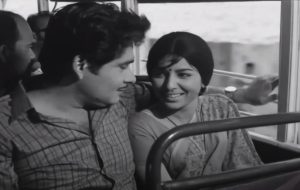When Adoor Gopalakrishnan, one of the internationally acclaimed Indian filmmakers, launched his first feature film Swayamvaram five decades ago, it was after many years of sustained effort. After passing out of FTII, Pune in 1965, he found it difficult to get a producer who would back him. Hence, he took the initiative of forming a cooperative for film production along with his friends. There was not much awareness of international cinema in his state of Kerala at that time. Realizing the need for establishing a film culture, he took yet another initiative of setting up a film society along with his associates and brought out literature on cinema. Adoor himself penned articles in Malayalam to spread awareness about the medium.
The establishing of the cooperative helped Adoor in launching his first film Swayamvaram which was jointly financed by the erstwhile Film Finance Corporation and his Chitralekha Film Cooperative. It is based on a story and script by Adoor Gopalakrishnan who was assisted by K. P. Kumaran. The film won National Awards for Best Film, Best Director (Adoor Gopalakrishnan), Best Actress (Sharada) and Best Cinematography (Mankada Ravi Varma). The golden jubilee is an occasion to look at the film now, analyze it and place it in Adoor’s oeuvre.
Exposition
The film’s opening title sequence is shot inside a bus with a variety of passengers, some of whom are dozing off. Among them is a young couple with their faces animated. They exchange glances. The bus comes to a halt and we see them checking into a hotel room. The man asks his lover whether she regrets it. He wonders whether they gave enough thought to it. We realize that they might have eloped. A group of devotees pass by on the road in a procession chanting bhajan. It may appear odd to see the film showing the couple making love with the background of the bhajan on the soundtrack. The director’s intention here is revealed in Adoor’s interview in which he has said that he paired bhakti (devotion) with sex in that scene. [1] The essence of bhajan is bhakti. By being paired with bhakti, sex gets associated with devotion as another aspect of it. Separated from their families, they are mutually dependent on each other which leads to devotion as well as the fear of losing the loved one as seen in the dream sequences which follow.
Synopsis

In Swayamvaram, a young couple, Sita (Sharada) and Vishwam (Madhu) fall in love perhaps against the wishes of their parents and leave their village to live together in the city. They face the challenge of surviving on their own in a climate of acute unemployment. As Vishwam’s literary aspirations are crushed, he takes up a teaching job but loses it. Later he gets only a low paying job of a clerk in a sawmill that too by replacing a dismissed employee who worked for twelve years there. Now that the couple have a child, Vishwam has to bear with the insinuation of the previous employee who stalks him. Vishwam is haunted by the hounding but his job is important to him. When he falls sick the situation becomes grave.
Structure
Swayamvaram (1972) starts with the journey to the city of the young couple with their illusions followed by the hard reality they experience there. What Sita goes through has some parallel with the female protagonist Sita in the epic “Ramayana” which gives a resonance to the film. The title refers to the swayamvaram (meaning one’s own choice) of Sita who wedded Rama out of many princes in the epic. There is the picture depicting it that hangs on the wall of the house of Vishwam and Sita. Vishwam is her own choice for Sita in the film and not that of her family so it is a swayamvaram for her too. But Sita in the film is not exactly in the mould of Sita in the epic. She elopes with her lover to live together with him, making the subject daring for its time.
In the Forests of the Plight
 Just as Sita in the epic had to undergo hardships by having to go to forest, in the film also Sita has to go through adversities. The dream sequences in the early part of the film portend Sita losing Vishwam. He climbs down the rocks towards the sea as she keeps gesturing to him to come back. In another dream sequence Vishwam lies down keeping his head on the railway track with the approaching train’s sound on the soundtrack. She runs upto him and forces him to get up. In yet another sequence she chases him in the woods and loses him. It has memorable tracking shots of her running in the forest looking out for him. Sita being renounced by Rama in the last part of the epic (Uttarakandam) has its echo in Sita losing Vishwam in the end.
Just as Sita in the epic had to undergo hardships by having to go to forest, in the film also Sita has to go through adversities. The dream sequences in the early part of the film portend Sita losing Vishwam. He climbs down the rocks towards the sea as she keeps gesturing to him to come back. In another dream sequence Vishwam lies down keeping his head on the railway track with the approaching train’s sound on the soundtrack. She runs upto him and forces him to get up. In yet another sequence she chases him in the woods and loses him. It has memorable tracking shots of her running in the forest looking out for him. Sita being renounced by Rama in the last part of the epic (Uttarakandam) has its echo in Sita losing Vishwam in the end.
Illusion & Reality
Sita and Vishwam are shown acting like lovers in commercial cinema in the dream sequences. The theme of illusion is taken up in a dream sequence showing posters of hero and heroine in love from Malayalam commercial cinema in which love is romanticized. Sita and Vishwam would have grown up watching such films and imagined that life will be rosy as it is depicted in films. Later in Swayamvaram it turns out very hard to survive as job is very difficult to get for both of them. Without any support system Sita and Vishwam are dependent on each other. Reality dawns on Sita when Vishwam falls ill.
Retrenchment Theme
 Vishwam happens to see briefly a leftist party meeting in which the speaker talks about how the working class is misled by various parties. He adds that all of them obstruct the struggle of workers and their liberation. Much later in Swayamvaram after losing his job, there is a scene which shows a political march in protest against retrenching workers. Vishwam quietly watches it passing by. It seems the film was not given an award at the Moscow International Film Festival in which it was nominated. Adoor has said that the jury was surprised that Vishwam didn’t join the march of the workers which costed the film an award. Vishwam himself has been retrenched from his job. Yet he doesn’t join the march. Adoor has said that the reason is “he doesn’t see himself as part of this. This has to be understood because the other thing is simplistic that he also joins it. That’s the kind of films we used to send to Moscow.” [1] Vishwam doesn’t belong to the working class. Hence it wouldn’t have been appropriate to show him in the stock manner which would satisfy the expectation of the audience and an agenda driven jury. This is an important aspect of Swayamvaram which makes it stand apart.
Vishwam happens to see briefly a leftist party meeting in which the speaker talks about how the working class is misled by various parties. He adds that all of them obstruct the struggle of workers and their liberation. Much later in Swayamvaram after losing his job, there is a scene which shows a political march in protest against retrenching workers. Vishwam quietly watches it passing by. It seems the film was not given an award at the Moscow International Film Festival in which it was nominated. Adoor has said that the jury was surprised that Vishwam didn’t join the march of the workers which costed the film an award. Vishwam himself has been retrenched from his job. Yet he doesn’t join the march. Adoor has said that the reason is “he doesn’t see himself as part of this. This has to be understood because the other thing is simplistic that he also joins it. That’s the kind of films we used to send to Moscow.” [1] Vishwam doesn’t belong to the working class. Hence it wouldn’t have been appropriate to show him in the stock manner which would satisfy the expectation of the audience and an agenda driven jury. This is an important aspect of Swayamvaram which makes it stand apart.
The theme of retrenchment has been treated in its complexity in Swayamvaram. While the sawmill owner appears to be unfair in terminating a long-time employee, the friendly tutorial college owner with debts is forced to ask Vishwam to leave. The scene in which the owner takes Vishwam for a drinking spree is memorable.
Safety and Security of Women
Women’s safety is yet another theme in the film. Vishwam and Sita move to a second hotel which is cheaper. Sita gives away her golden bangles, perhaps the only precious jewelry she has to Vishwam. It’s for buying a mangalsutra (golden signet in a chain worn by a married woman) to let men know of her marital status and ward them off. This scene also suggests that Sita and Vishwam are living together perhaps without getting married. Sita is terrified by the way she sees a drunkard when she opens the hotel room door on hearing the knocking of the door. She is even afraid of opening the door when Vishwam arrives. Sita wearing the mangalsutra doesn’t restrain smuggler Vasu who has an eye on her. Three drunkards try to barge into her house and make unsavoury remarks about her.
The Women in the Film

Swayamvaram came up with very well etched characters, particularly women. Sita is a bold woman who takes the courage to leave her family to live with her lover. She is resolute and strongly willed unlike Vishwam who keeps wondering whether they made the right choice. Kalyani (K.P.A.C. Lalitha), is a prostitute living in the opposite house whose husband visits her to collect money for liquor. She is smart enough not to let him exploit her at some point. The middle-aged widow Janaki (Adoor Bhavani), the rice seller neighbour of Sita, is very helpful to her. Sita protects herself from the prying eyes of men and lives with dignity. It is impossible for the smuggler Vasu to make advances to her as Kalyani says.
Casting

Casting of Madhu as Vishwam was right as he underplays the role unlike most of the actors of that period who were known for their dramatic style of acting. Sharada was known as a talented actress and she had already won the National Award for Best Actress for Thulabharam (1968). She was the right choice for Sita and she got her second National award for Swayamvaram. Gopi turned out to be a great discovery by giving a haunting performance as the fired employee. The rest of the cast also performed well in the film.
The Ending
 In the end when Vishwam passes away, Vishwam’s colleague suggests that she can live with his family. Janaki tells Sita to return to her parents. Sita rejects both the options. Once again, she makes her own choice. Her condition can be looked at in terms of the parallel of her situation with Sita in “Ramayana” who was renounced by Rama in Uttarakandam. In the last scene there are the sounds of thunder and pouring rain as Sita feeds her child. Water leaking from the roof falls down over the picture of swayamvaram on the wall which is lit up by the lightning. The last shot is ambiguous as it shows Sita having an eye on the closed door, concerned about safety. While she is willing to face the world on her own, the future is uncertain.
In the end when Vishwam passes away, Vishwam’s colleague suggests that she can live with his family. Janaki tells Sita to return to her parents. Sita rejects both the options. Once again, she makes her own choice. Her condition can be looked at in terms of the parallel of her situation with Sita in “Ramayana” who was renounced by Rama in Uttarakandam. In the last scene there are the sounds of thunder and pouring rain as Sita feeds her child. Water leaking from the roof falls down over the picture of swayamvaram on the wall which is lit up by the lightning. The last shot is ambiguous as it shows Sita having an eye on the closed door, concerned about safety. While she is willing to face the world on her own, the future is uncertain.
Swayamvaram is one of the first Malayalam films that featured direct recording of sound (synchronized sound) and outdoor locales. It’s also considered to be the first film in Indian cinema that used sound as a leitmotif: There is the recurrent sound of wood being cut in the sawmill. This cutting sound is especially powerful when Vishwam passes away.
In an interview with C.S. Venkiteswaran, Adoor has said that the Film Finance Corporation (FFC) rejected his application for finance for a film based on a script written by C.N. Sreekandan Nair as it was a love story. FFC didn’t sanction the loan because the script didn’t take up any of the issues facing India. [2] Perhaps the issue of unemployment that Swayamvaram deals with helped in getting the finance from FFC. To compare it with Adoor’s second film onwards upto Anantaram, the approach in the latter is that of a biography of an individual. The films are very much rooted in the social landscape of Kerala but they are not issue based. Even in Swayamvaram, while the story deals with a social issue, it has other dimensions too. Its parallel with the epic “Ramayana” gives it a connotative meaning.
In retrospect the title reflects Adoor’s own choice of treading the untrodden path of art cinema with all its risks. He has been hugely successful in creating a body of work that is world class and becoming a major force in Indian cinema. A pioneer of the new Malayalam cinema movement, he inspired several other art filmmakers. Swayamvaram’s daring subject, complex treatment of the theme of retrenchment, parallel with the epic and ambiguous ending mark Adoor’s first film, revealing an original style of filmmaking which has helped the film’s longevity even after five decades.
References
- VK Cherian in conversation with Adoor Gopalakrishnan, The creative world of Adoor Gopalakrishnan-Episode One-Swayamvaram Swayamvaram50 Channel on YouTube, 2022
- S. Venkiteswaran in conversation with Adoor Gopalakrishnan, C.S. Venkiteswaran in Conversation with Adoor Gopalakrishnan Part 2: Film Societies, Festivals and Early Films, Sahapedia.org, 2021






Leave a Reply
You must be logged in to post a comment.